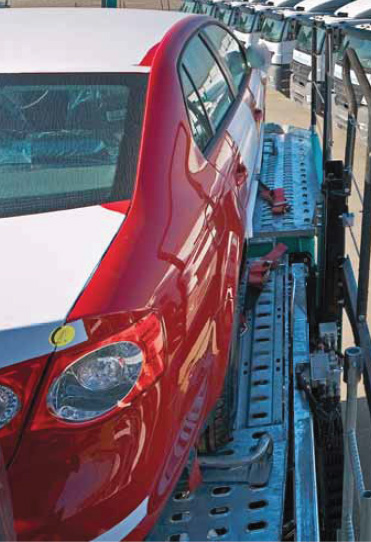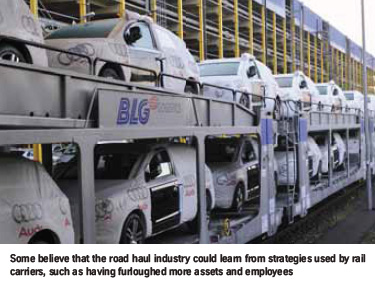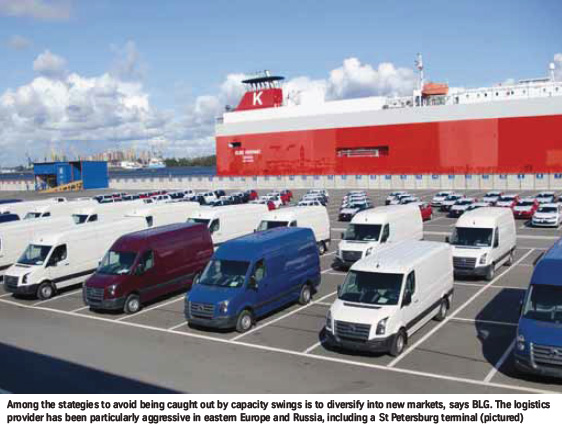How can a country have severe over-capacity for vehicle transport one year, and under-capacity the next? Andrew Williams investigates the factors affecting such swings in the US and Europe, and uncovers the delicate relationships that steer the whole market
Many people within the finished vehicle logistics industry are expressing concern about the lack of adequate road trucking provision, with some pointing out– particularly in North America–that it has taken the sector less than a year to swing from severe overcapacity to a scenario where it may now be facing the prospect of under capacity, despite the market still being well off the peak levels experienced in 2007. In Europe, while the market is more uncertain, there have also been calls (for example from the ECG) for significant reinvestment in new capacity to meet future demand. Against a background of ongoing financial austerity, it appears to be something of a conundrum that there is a growing groundswell of support for the idea of a large financial injection in the sector. So, what exactly is the situation on the ground and, if the sector really is facing the threat of under capacity, what is the best way forward?

The North American situation
Many casual readers of the logistics trade publications in the United States would be forgiven for coming away with the impression that there are currently not enough trucks on the road to handle future increases in North American car sales, but does this view match up with the reality? According to Jeff Martin, from transporter-builder Cottrell, the number of trucks on the road has declined in recent years from attrition and the dissolution of several companies whose fleets were largely scrapped when they went out of business. Although the industry was largely shielded from the negative effects of this contraction during the downturn, there are signs that it might begin to suffer as the market picks up.
“We believe that this decline was not a problem because it coincided with a dramatic drop off in vehicle sales. If sales improve, as many are predicting, this shortfall will become more apparent,” says Martin.
This sense of a problem looming on the horizon is echoed by Scott Crail at American Honda. “While we at Honda have not felt the heat of under capacity yet, we are concerned that it won’t be long until there just aren’t enough drivers to meet the demands of a steadily increasing new vehicle market,” he says. For Pat O’Brien, of transporter builder Delavan Industries, the industry is facing under capacity for a variety of reasons. Firstly, moving business from union to non-union carriers sometimes has an impact, as many of the non-union carriers use a percentage of revenue to pay the driver. Many non-union carriers have experienced OEM pressure to reduce rates, and therefore offer lower pay structures for their drivers. “In 1990 a car-hauling driver made a 50-60% differential from a driver bumping docks. Today they are paid almost the same. Car hauling is not a trade you learn overnight. Why would a person go through all the training involved to make the same money? There are a lot of truck drivers out there, but not that many car-haulers,” says O’Brien.
Moreover, since the deregulation of the industry in 1986, carriers have faced a tremendous amount of OEM pressure to reduce costs. This has resulted, says O’Brien, in a reduction in rates to a point where the recapitalization of equipment is difficult. Whereas in 1990, the average age of a large carrier’s fleet was probably around 5-7 years, today most large fleets have an average age of 14 years. Maintenance costs, as a percentage of revenue, have risen from around 11% to more than 18% in some cases because of the age of the fleets. “When the return on investment in this industry is under constant attack, it is tough to find a finance group willing to invest in equipment,” says O’Brien.
A further cause of the under capacity may also be that car hauliers are finding it increasingly difficult to find drivers. “We’re hearing that former drivers have moved on to other, likely less strenuous, jobs and car haulers are finding it difficult to find drivers willing to work as hard as this job requires. Also, it seems that they are hesitant to pull the trigger on hiring and pulling equipment off the fence until they are convinced that the volume increases are long-term,” says Crail.
Is investment in capacity the solution?
Given this assessment, many in the industry highlight the need for significant reinvestment to meet future demand.  However, against increasing competition and pressure from investment groups, the need for LSPs to earn adequate returns on investment will likely remain a key objective. “Without some upward movement in the rates, I think that there will be serious delivery failures in many locations. I learned a lesson long ago about auto delivery–the logistics groups can drive everything, until such time as they impact sales,” says O’Brien.
However, against increasing competition and pressure from investment groups, the need for LSPs to earn adequate returns on investment will likely remain a key objective. “Without some upward movement in the rates, I think that there will be serious delivery failures in many locations. I learned a lesson long ago about auto delivery–the logistics groups can drive everything, until such time as they impact sales,” says O’Brien.
“We are going to see [the lack of capacity have] negative impacts on sales in some areas, and that will impact where this industry goes in the future. Without reinvestment, we are on the verge of some type of collapse,” he adds. More cautiously, Cottrell’s Martin believes customers are best placed to determine the need for reinvestment in capacity. Cottrell’s experience has been that LSPs have very different strategies regarding reinvestment and capacity planning. “On one end of the spectrum, we deal with companies that rely heavily on refurbishment as a primary strategy to keep their fleets operational, all the way to companies that ‘retire’ equipment as soon as it is depreciated, and everything in between,” says Martin.
For Honda’s Crail, there is simply a pressing need to have more drivers and equipment to meet the increasing demand. “Increased investment in these two areas will likely go a long way to prepare the industry for the coming, if not current, storm,” he says.
“Once manufacturers are confident that there is sufficient capacity, carriers can start to add value by investing in technology [such as] improved vehicle tracking,” adds Crail’s boss at American Honda, Dennis Manns.
Beyond boom and bust
So how best can the vehicle trucking sector avoid repeating the ongoing cycles of under and overcapacity in the future? For O’Brien, the key is for carriers to develop trust and longterm customer relationships.
“Years ago, if you were a carrier for a major OEM, and had a problem, the OEM and the carrier worked together to solve them. Today, the answer to any problem is to put the business up for ‘test marketing,’” he says. “The OEMs need to recognize what has happened to this industry. There will always be cycles but good partnerships get companies through them.” The industry could also learn from the strategies adopted by rail carriers. Eager to avoid mistakes made during the last downturn, many railways have furloughed employees–which is temporary rather than permanent redundancy–and stored power relatively ready for quick redeployment. If car hauliers were to follow the same model, even to a lesser degree, the trucker with the most readily available capacity may be better placed to win business. “The earliest clamdigger gets a crack at the biggest clams!” says Crail.
 On a more technical note, Crail’s colleague, Gary Cooper, predicts that if manufacturers as a group stick with their (apparent) commitment to a “pull” rather than a “push” sales model, the recovery of the market may be fairly dependable. “If resolve weakens and certain manufacturers return to the ‘produce beyond demand’ and high-incentive model, ongoing cycles of under and overcapacity are more likely,” he says. However, companies might also be well advised to avoid any sort of knee-jerk reaction to perceived fluctuations in capacity. Martin, for one, doesn’t necessarily agree with the premise that there are ongoing cycles of under and overcapacity in the industry at all. “Given the volatility of the North American vehicles industry, especially over the last five years, it appears to us that the trucking sector has done an excellent job of managing their capacity and we would expect that they will continue to do so in the future,” he says.
On a more technical note, Crail’s colleague, Gary Cooper, predicts that if manufacturers as a group stick with their (apparent) commitment to a “pull” rather than a “push” sales model, the recovery of the market may be fairly dependable. “If resolve weakens and certain manufacturers return to the ‘produce beyond demand’ and high-incentive model, ongoing cycles of under and overcapacity are more likely,” he says. However, companies might also be well advised to avoid any sort of knee-jerk reaction to perceived fluctuations in capacity. Martin, for one, doesn’t necessarily agree with the premise that there are ongoing cycles of under and overcapacity in the industry at all. “Given the volatility of the North American vehicles industry, especially over the last five years, it appears to us that the trucking sector has done an excellent job of managing their capacity and we would expect that they will continue to do so in the future,” he says.
The European situation
In Europe, the capacity situation is a little more complex. Although the number of new vehicle registrations increased in Western Europe by around 2% in the first half of 2010, they declined by 29% in Germany and 14% in the new EU Member States in central and eastern Europe. According to Wolfgang Stöver, at BLG Automobile Logistics, the slight increase in Western Europe was mainly driven by scrappage bonus-schemes in volume markets, where he admits that there might be an under capacity at present. However, in Germany, BLG’s main field of trucking activities, it is facing the opposite situation where, following the scrappage bonus in 2009, there is a much weaker market in 2010. As a result, it is still facing overcapacities and eroding revenues and profits.
In Germany, after a very high utilisation of the fleet in 2009, there is a weaker market in 2010 in general. However, German OEMs have an increased number of export vehicles to be transported to ports for shipment, which may help to take up some of the slack. Another reason for under capacity in certain areas, says Stöver, is that, following the crisis in 2008/2009, many hauliers chose to postpone expansion investments in new trucks until they were confident of an improvement in market prospects.
“The problem in recruiting drivers is a general problem that already existed before the crisis and will remain in the future,” he adds.
BMW, for example, reports that it has seen an increase in the amount of subcontracted carriers arriving at its plants, a trend it attributes to providers’ reluctance to redeploy their fleets (see page 16 for more). For Suk Yong (Sean) Kim, CEO and president of Glovis Europe, difficulties in securing truck capacities to some destinations is caused not by shortages of investment in trucks but by an imbalance in traffic flows from east to west and the flexibility in car production related to market demands.
“The well-known east-west imbalance, [characterised by] eastern European production sites and the main markets in the West, against low demand in eastern Europe, is presenting challenges [for us] in securing enough capacity,” he says Echoing the situation across the Atlantic, a lack of investment during the global downturn is likely to lead to a need for significant reinvestments in the coming years. However, as Stöver points out, most European hauliers did keep trucks and drivers in “warm and cold” lay off. Besides this “furlough not fire” strategy, BLG also purchased 80 new trucks in 2009/2010 in an effort to counteract the cycles of economic downswing and upturn.
In Kim’s view is that although the European trucking sector has recently reverted to a healthier situation following a period of overcapacity, LSPs should carefully re-invest in new truck capacity in line with general demand, whilst also retaining flexibility across all operational areas.
“But for now, the main target should be a better utilisation of the existing capacity. We might be able to support LSPs by redirecting vehicle flows from overseas, or by sharing transportation demands with other OEMs,” he says.
Trucking into the future
Looking ahead, Kim does not anticipate that the industry will avoid the problems of under or overcapacity, but could still do much to minimise the cycle, for example by encouraging LSPs to work much closer together to share capacity. “OEMs should [also] be more open by sharing information among each other and, if possible, to harmonise vehicle flows,” he says.
Some predict that, in the face of ongoing cycles, many trucking companies, because of their relatively small size, may be tempted to postpone investments in bad times and will only be able to react to improved situations after a time lag. One possible solution is to invest in an anti-cycle manner, provided that the financial status of the company allows. Moreover, it may also be advantageous to diversify regionally, so that there is compensation if some markets are rising while others fall.
“Another strategy is the early presence and investment in emerging markets. BLG is focussing on the future developments in eastern Europe and Russia by building up a network there,” says Stöver.
“We see further possibilities in an intensified cooperation between the companies and competitors by pooling and exchanging equipment and probably drivers. The equipment could even be provided by charter companies that invest and charter out the equipment,” he adds.
One of the lessons to be learned is that a strategy of increased cooperation, both between LSPs themselves and between LSPs and OEMs, could emerge as one of the most effective ways for the industry to react to the problems of over and under-capacity. If combined with a willingness to be flexible, and also to adopt intelligent employment policies, the industry is likely to be much better placed to handle any future volatility in the vehicle trucking sector.




































